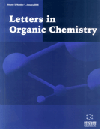- Home
- A-Z Publications
- Letters in Organic Chemistry
- Previous Issues
- Volume 17, Issue 4, 2020
Letters in Organic Chemistry - Volume 17, Issue 4, 2020
Volume 17, Issue 4, 2020
-
-
Diarylmethanols Synthesis by Nickel(II)-catalyzed Addition of Arylboronic Acids to Aryl Aldehydes
More LessAuthors: Fusheng Bie, Xuejing Liu, Meng Wang, Haizhu Cui, Tang Li, Jie Ma and Han CaoA practical procedure for the addition of arylboronic acids to aromatic aldehydes has been developed in the presence of NiCl2(PPh3)2/1,3-bis-(2,6-diisopropylphenyl)imidazolium chloride (IPr·HCl) system with good yield. Generally, electron-rich and -neutral aryl aldehydes showed excellent reactivity and provided desired products in high yields. This procedure will provide new way to the synthesis of diarylmethanols.
-
-
-
Synthesis, Molecular Docking, and In Vitro Investigation of 1,1'-Diaryl-3,3'-(p-phenylenedicarbonyl) dithioureas as Urease Inhibitors
More LessSynthesis of some 1,1'-diaryl-3,3'-(p-phenylenedicarbonyl)dithioureas was accomplished in two steps. Dithioureas were prepared under inert conditions with significantly high yields. Inhibitory activity of dithiourea compounds was investigated against urease enzyme. All the synthesized compounds were evaluated for their urease inhibitory activities, and molecular docking studies were carried out to ascertain the inhibito Read More
-
-
-
A Combined Topological ELF, NCI and QTAIM Study of Mechanism and Hydrogen Bond Controlling the Selectivity of the IMDC Reaction of Nitrone-alkene Obtained from m-allyloxybenzaldehyde
More LessAuthors: Fouad Chafaa, Abdelmalek K. Nacereddine and Abdelhafid DjerourouThe selectivity and molecular mechanism of the intramolecular [3+2] cycloaddition (IMDC) reaction of nitrone-alkene generated from m-allyloxybenzaldehyde has been studied computationally using B3LYP/6-31G(d) theoretical method. The energy profiles indicate that this IMDC reaction favours kinetically the formation of the fused-endo, as observed experimentally. The solvent has no influence on the mechanis Read More
-
-
-
Gold Nanoparticle Functionalized Mesoporous Silica-Chitosan as Efficient and Recyclable Catalyst for the Green One-Pot Synthesis of 4H-pyran Derivatives in Aqueous Medium
More LessAuthors: Razieh Azimi, Zahra Lasemi and Ayemeh B. HashkavayiGold nanoparticle functionalized mesoporous silica-chitosan (Au NPs/silica-chitosan) as an environmentally benign and heterogeneous nanocatalyst was prepared and its properties were characterized using field emission scanning electron microscopy (FE-SEM) and fourier transform infrared (FT-IR). The catalytic activity of Au NPs/silica-chitosan was studied in the synthesis of biologically important 4H-pyran derivatives. In these re Read More
-
-
-
An Efficient, Potassium Carbonate-Catalysed, Three-Component Reaction of Aldehydes, Malononitrile and Amidines Leading to Highly Functionalized Pyrimidines in Aqueous Media
More LessAuthors: Seddigheh Mohammadi, Dadkhoda Ghazanfari and Zahed Karimi-JaberiVarious 4-amino-5-cyanopyrimidines were readily prepared in a few minutes with good yields through a one-pot, three-component reaction of aldehydes, malononitrile and amidines in aqueous media in the presence of catalytic amounts of potassium carbonate. Short reaction times, high efficiency, generality of the method, synthesis of new derivatives, inexpensiveness, and non-toxicity of the catalyst/solvent are the intere Read More
-
-
-
Influence of Carbohydrate Residues on Antibacterial Activity of Vancomycin
More LessThis paper presents synthesis of vancomycin derivatives modified with selected 1- and 2-aminoalditols to carboxylic function and 2,5-anhydro-D-mannose and D-talose to amino function of vancosamine via reductive alkylation. MIC and MBC of these derivatives were determined for reference strains of bacteria: Staphylococcus aureus ATCC 25923, ATCC 6538, ATCC 6538/P, S. epidemidis ATCC 14490, E. faecium PCM 1859, E. fa Read More
-
-
-
Synthesis and Anti Cervical Cancer Activity of Novel 5H-Thiochromeno [4,3-d]pyrimidines
More LessAuthors: Dhananjay Pandya and Yogesh NaliaparaA series of novel 5H-Thiochromeno[4,3-d]pyrimidine derivatives were synthesized, purified and characterized by different spectroscopy techniques such as 1H NMR, 13C NMR, Mass and Elemental Analysis. The new compounds were evaluated for their anti-cervical cancer activity on Human Cervical Cell Line HeLa. They were found to be potent anti-cervical cancer agents with GI50 values less than 10 μg/mL with respect to po Read More
-
-
-
Pd-Catalyzed Carbonylation-cyclization of N′-(2-bromophenyl)benzamidines by Chloroform as a CO Precursor for the Synthesis of Quinazolin-4(3H)-ones
More LessAuthors: Abbasian Sepideh, Kabirifard Hassan and Mahdavi MohammadWe present an efficient method for the synthesis of quinazolin-4(3H)-ones via Pdcatalyzed carbonylation-cyclization of N′-(2-bromophenyl)benzamidines. Chloroform cleanly generated CO under mild conditions. This method allows for the carbonylation-cyclization of N′-(2- bromophenyl)benzamidines in the presence of Pd(OAc)2 to give quinazolin-4(3H)-ones in good to excellent yields.
-
-
-
Synthesis and Molecular Docking Studies of Novel Triazole Derivatives as Antioxidant Agents
More LessAuthors: Musa Özil, Güven Tacal, Nimet Baltaş and Mustafa EmirikA series of 1,2,4-triazole and 1,2,4- thiadiazole derivatives were prepared starting from ethyl 4-(3-methyl-5-oxo-1,5-dihydro-4H-1,2,4-triazol-4-yl)benzoate. Firstly, both ethyl ester groups were simultaneously transformed into hydrazide groups, then into thiosemicarbazide groups using both microwave- assisted and conventional methods. The latter products were interacted with NaOH and H2SO4 to form ring assemblies con Read More
-
-
-
Envirocat EPZ-10: An Efficient Catalyst for the Synthesis of 1,2,4-Triazolidine-3-thiones
More LessAuthors: Pradeep M. Mhaldar and Dattaprasad M. PoreA simple and environmentally benign room temperature synthesis of 1,2,4-triazolidine-3- thiones is described using Envirocat EPZ-10R as a solid acid catalyst in the aqueous medium. The use of Envirocat EPZ-10R as a green catalyst, reusability of the catalyst, water as a universal solvent and good yields of the product are the attractive features of the present method.
-
Volumes & issues
-
Volume 22 (2025)
-
Volume 21 (2024)
-
Volume 20 (2023)
-
Volume 19 (2022)
-
Volume 18 (2021)
-
Volume 17 (2020)
-
Volume 16 (2019)
-
Volume 15 (2018)
-
Volume 14 (2017)
-
Volume 13 (2016)
-
Volume 12 (2015)
-
Volume 11 (2014)
-
Volume 10 (2013)
-
Volume 9 (2012)
-
Volume 8 (2011)
-
Volume 7 (2010)
-
Volume 6 (2009)
-
Volume 5 (2008)
-
Volume 4 (2007)
-
Volume 3 (2006)
-
Volume 2 (2005)
-
Volume 1 (2004)
Most Read This Month
Article
content/journals/loc
Journal
10
5
false
en


